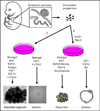Three-dimensional pancreas organogenesis models
- PMID: 27615129
- PMCID: PMC5021194
- DOI: 10.1111/dom.12720
Three-dimensional pancreas organogenesis models
Abstract
A rediscovery of three-dimensional culture has led to the development of organ biogenesis, homeostasis and disease models applicable to human tissues. The so-called organoids that have recently flourished serve as valuable models bridging between cell lines or primary cells grown on the bottom of culture plates and experiments performed in vivo. Though not recapitulating all aspects of organ physiology, the miniature organs generated in a dish are useful models emerging for the pancreas, starting from embryonic progenitors, adult cells, tumour cells and stem cells. This review focusses on the currently available systems and their relevance to the study of the pancreas, of β-cells and of several pancreatic diseases including diabetes. We discuss the expected future developments for studying human pancreas development and function, for developing diabetes models and for producing therapeutic cells.
Keywords: bioengineering; diabetes; disease; modelling; organoids; spheres; spheroids; stem cells; therapy.
© 2016 John Wiley & Sons Ltd.
Conflict of interest statement
statement The authors have no conflict of interest to disclose.
Figures


References
-
- Blauer M, Nordback I, Sand J, Laukkarinen J. A novel explant outgrowth culture model for mouse pancreatic acinar cells with long-term maintenance of secretory phenotype. Eur J Cell Biol. 2011;90:1052–1060. - PubMed
-
- Houbracken I, de Waele E, Lardon J, et al. Lineage tracing evidence for transdifferentiation of acinar to duct cells and plasticity of human pancreas. Gastroenterology. 2011;141:731–741. 741 e731-734. - PubMed
-
- Paraskevas S, Maysinger D, Wang R, Duguid TP, Rosenberg L. Cell loss in isolated human islets occurs by apoptosis. Pancreas. 2000;20:270–276. - PubMed
-
- Thompson N, Gesina E, Scheinert P, Bucher P, Grapin-Botton A. Rna profiling and chromatin immunoprecipitation-sequencing reveal that ptf1a stabilizes pancreas progenitor identity via the control of mnx1/hlxb9 and a network of other transcription factors. Mol Cell Biol. 2012;32:1189–1199. - PMC - PubMed
-
- Ornitz DM, Palmiter RD, Messing A, et al. Elastase i promoter directs expression of human growth hormone and sv40 t antigen genes to pancreatic acinar cells in transgenic mice. Cold Spring Harb Symp Quant Biol. 1985;50:399–409. - PubMed
Publication types
MeSH terms
Grants and funding
LinkOut - more resources
Full Text Sources
Other Literature Sources
Medical

